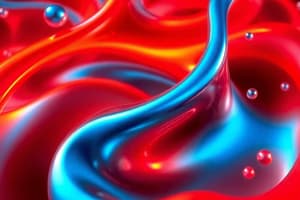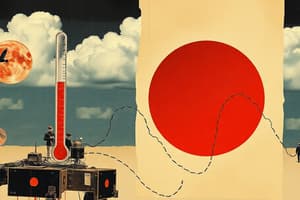Podcast
Questions and Answers
Consider a container divided into two equal parts. One side contains a gas, and the other is a vacuum. If the barrier is removed, and the gas expands to fill the entire container, what happens to the entropy of the system?
Consider a container divided into two equal parts. One side contains a gas, and the other is a vacuum. If the barrier is removed, and the gas expands to fill the entire container, what happens to the entropy of the system?
- The entropy increases because the gas molecules have more possible arrangements. (correct)
- The entropy decreases because the gas molecules are now more spread out.
- The entropy remains the same because no energy was added to the system.
- The entropy fluctuates as the gas molecules equilibrate.
Which of the following best describes entropy in thermodynamic terms?
Which of the following best describes entropy in thermodynamic terms?
- A measure of the total energy contained within a system.
- A measure of the degree of disorder in **how energy is distributed** within a system. (correct)
- A measure of the average kinetic energy of particles in a system.
- A measure of the potential energy stored within chemical bonds.
Why does a mixture of gases at a high temperature typically have higher entropy than a crystal at low temperature?
Why does a mixture of gases at a high temperature typically have higher entropy than a crystal at low temperature?
- Crystals at low temperatures are more complex.
- Gases at high temperatures have more ordered molecular arrangements.
- Crystals at low temperatures have greater energy dispersal.
- Gases have more ways to distribute energy and position than the crystal. (correct)
Which of the following processes typically involves an increase in entropy?
Which of the following processes typically involves an increase in entropy?
What statement accurately captures the relationship between entropy and the stability of a system?
What statement accurately captures the relationship between entropy and the stability of a system?
Consider a deck of cards that is arranged in perfect order by suit and rank. What would happen to the entropy if the cards were shuffled thoroughly?
Consider a deck of cards that is arranged in perfect order by suit and rank. What would happen to the entropy if the cards were shuffled thoroughly?
In what scenario would the entropy of a system decrease?
In what scenario would the entropy of a system decrease?
If you have two gases in separate containers, and you allow them to mix into a single container, what happens to the entropy?
If you have two gases in separate containers, and you allow them to mix into a single container, what happens to the entropy?
Why does the entropy of a substance generally increase when it changes from solid to liquid to gas?
Why does the entropy of a substance generally increase when it changes from solid to liquid to gas?
How does the dissolution of an ionic solid in water affect the entropy of the system?
How does the dissolution of an ionic solid in water affect the entropy of the system?
For a reaction where there is an increase in the number of gas molecules, what happens to the entropy of the system?
For a reaction where there is an increase in the number of gas molecules, what happens to the entropy of the system?
Consider the reaction: $N_2(g) + 3H_2(g) \rightarrow 2NH_3(g)$. What is the expected change in entropy?
Consider the reaction: $N_2(g) + 3H_2(g) \rightarrow 2NH_3(g)$. What is the expected change in entropy?
Which of the following processes would likely result in a decrease in entropy?
Which of the following processes would likely result in a decrease in entropy?
How does increasing the temperature of a system (without a change of state) affect its entropy?
How does increasing the temperature of a system (without a change of state) affect its entropy?
Given that benzene is a more complex molecule than water, how do their standard entropy values typically compare in the liquid or gaseous phase?
Given that benzene is a more complex molecule than water, how do their standard entropy values typically compare in the liquid or gaseous phase?
Consider the reaction: $CaCO_3(s) \rightarrow CaO(s) + CO_2(g)$. How does the entropy change?
Consider the reaction: $CaCO_3(s) \rightarrow CaO(s) + CO_2(g)$. How does the entropy change?
Which of the following leads to an increase in entropy?
Which of the following leads to an increase in entropy?
What would happen to the entropy of the system if water vapor turned into liquid water?
What would happen to the entropy of the system if water vapor turned into liquid water?
Flashcards
Entropy
Entropy
A measure of the amount of disorder in a system.
Entropy Increase
Entropy Increase
Systems naturally move from order to disorder when unconstrained.
Disordered State
Disordered State
A state where energy is spread out randomly within a system.
Molecular Collisions
Molecular Collisions
Signup and view all the flashcards
System Stability
System Stability
Signup and view all the flashcards
Entropy Changes During Physical Changes
Entropy Changes During Physical Changes
Signup and view all the flashcards
Ordered System
Ordered System
Signup and view all the flashcards
Disordered System
Disordered System
Signup and view all the flashcards
Entropy Symbol
Entropy Symbol
Signup and view all the flashcards
Entropy and State
Entropy and State
Signup and view all the flashcards
Molecular Size & Entropy
Molecular Size & Entropy
Signup and view all the flashcards
Dissolving and Entropy
Dissolving and Entropy
Signup and view all the flashcards
Temperature & Entropy
Temperature & Entropy
Signup and view all the flashcards
Gas Molecules and Entropy (Increase)
Gas Molecules and Entropy (Increase)
Signup and view all the flashcards
Gas Molecules and Entropy (Decrease)
Gas Molecules and Entropy (Decrease)
Signup and view all the flashcards
Solid Dissolving (Entropy Change)
Solid Dissolving (Entropy Change)
Signup and view all the flashcards
Moles of Gas Change (Entropy)
Moles of Gas Change (Entropy)
Signup and view all the flashcards
Aqueous Forming Solid (Entropy)
Aqueous Forming Solid (Entropy)
Signup and view all the flashcards
Study Notes
- Entropy is the measure of disorder within a system.
- A highly ordered system has low entropy, whereas a highly disordered system has high entropy.
- Entropy technically applies to disorder in energy terms, not just spatial arrangements.
- A system that is more disordered in space tends to have more disorder in its energy arrangement.
- A system becomes more stable when its energy is spread out in a more disordered state.
Entropy Changes During Physical Changes
- Entropy is given the symbol S.
- Standard entropy (measured at 298 K and a pressure of 1 bar) is given the symbol S°.
- The entropy usually increases as a solid gets more complicated.
Entropy of Water in Different States
- The entropy increases as the molecules become more disordered as you go from solid to liquid to gas.
- There isn't very big jump in entropy when ice turns to water because the hydrogen bonding between the liquid molecules imposes a fair amount of order on them even in the liquid.
Entropy of Benzene
- Benzene values are bigger than those of water-steam because benzene is a more complicated molecule.
- There are more ways of arranging the energy of the molecule in a disordered way over bigger molecules than smaller ones.
Dissolving an Ionic Solid in Water
- The ionic solid is highly ordered and has a relatively low entropy.
- Pure liquid water also has a certain amount of order.
- When the solid dissolves in water, the whole system becomes highly disordered as the crystal breaks up and the ions find their way between the water molecules, leading to an increase in entropy.
Entropy Changes When Temperature Changes
- Increasing the temperature increases the entropy of the system.
- If increasing the temperature involves a change of state in the material (from solid to liquid or liquid to gas), then you have increased the entropy.
Entropy Changes in Reactions Involving Gas Molecules
- Gases have higher entropies than solids or liquids because of their disordered movement.
- During a reaction in which there is a change in the number of molecules of gas present, entropy will change.
- Reactions involving an increase in the number of gas molecules will lead to increased disorder and entropy.
- Reactions involving a decrease in the number of gas molecules will lead to decreased disorder and entropy.
Predicting Entropy Changes During Reactions
- Crystalline solid going into solution leads to increased entropy because the solid is highly ordered, and the solution is disordered.
- Having more moles of gas on the left-hand side of the equation leads to the starting materials being more disordered than the products, and so there is a decrease in entropy.
- The presence of liquid water means that there will be far more disorder before the change than there is in the products, and copper(II) sulphate crystals formed will be very ordered, leading to entropy decreasing.
Studying That Suits You
Use AI to generate personalized quizzes and flashcards to suit your learning preferences.




